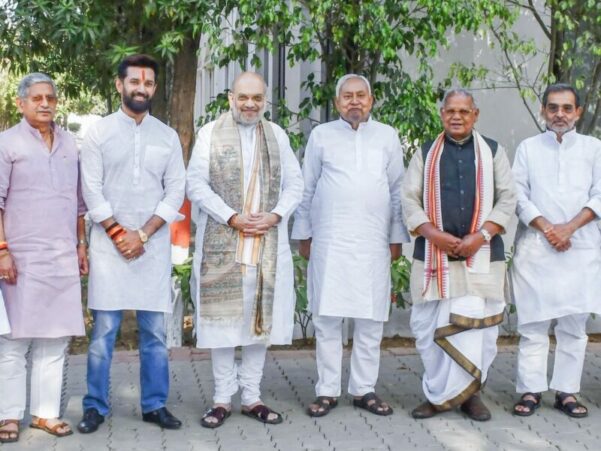
The 2025 Bihar Assembly elections have resulted in a stunning victory for the National Democratic Alliance (NDA), breaking a 20-year cycle of anti-incumbency and securing a decisive mandate across the state. As of 2:30 PM, the NDA led in 201 of the 243 seats, a remarkable gain of 76 seats since the 2020 Assembly elections. The BJP, the dominant force in the alliance, won 91 out of the 101 seats it contested, delivering an impressive 90% strike rate. This solidifies the BJP’s position as the leading party in the coalition, pushing aside its allies, including JD(U), which secured 79 seats.
On the other hand, the Grand Alliance (GA), which had long dominated the political landscape of Bihar, faced a significant collapse. The alliance dropped from 110 seats to just 36, losing 83 seats previously held by the opposition. This loss includes five of the opposition’s 12 strongholds, marking a significant erosion of the RJD–Congress coalition’s influence in the state.
Regional Sweep by NDA Across Bihar
The NDA’s success was not confined to a specific region but was widespread across Bihar. In the Tirhut region, the NDA surged ahead, leading in 56 seats, a gain of 20 seats from previous elections. In Magadh, the alliance strengthened its hold by winning 38 seats, also an increase of 20 seats. The Shahabad region, once a stronghold for the opposition, saw a dramatic turnaround, with the NDA leading in 20 seats compared to just two previously. Similar gains were visible across Mithila, Ang Pradesh, and the Seemanchal–Kosi belt, regions that had historically been dominated by the Grand Alliance.
This broad-based support across nearly all regions highlights the NDA’s consolidated vote base, which successfully cut across traditional caste and regional divides. The alliance’s ability to gain support in areas that were once strongholds of the opposition indicates a significant shift in the state’s political landscape.
Key Factors Behind the NDA’s Victory
One of the most decisive factors behind the NDA’s victory was Nitish Kumar’s women-focused welfare scheme, which transferred Rs 10,000 to 12.1 million women in Bihar. This initiative, widely referred to as “Das Hazari,” helped shift voter loyalty, especially among women. Cash transfer schemes for women have proven successful in other states, and in Bihar, it helped neutralize the anti-incumbency sentiment that had been building up over Nitish Kumar’s two-decade tenure.
Surveys show that 48.5% of women voted for the NDA, with 37% explicitly supporting the women’s employment scheme. Political analysts argue that this scheme was not just financial assistance but also a political gesture that strengthened Nitish Kumar’s position with women voters, a key constituency for the alliance.
The Chirag Paswan Factor
Another significant development in the 2025 elections was the rejoining of Chirag Paswan and his LJP (Ram Vilas) faction within the NDA. In the 2020 elections, Chirag had caused major setbacks to JD(U) by fielding candidates that cut into JD(U)’s margins in 34 constituencies. This year, however, Chirag’s LJP contested under the NDA banner, winning 29 seats and helping JD(U) recover from its poor performance in 2020. The partnership boosted JD(U)’s seat tally by nearly 48%, strengthening the coalition and uniting key vote banks, including upper castes, non-Yadav OBCs, and Mahadalits.
The “Jungle Raj” Narrative vs. Vote Theft Allegations
The NDA revived the potent “Jungle Raj” narrative, linking the RJD to its infamous 1990s legacy of kidnappings, extortion, and criminality. This narrative resonated strongly with women, Dalits, and Extremely Backward Classes (EBCs), groups that have historically been wary of the RJD’s rule.
In contrast, the Grand Alliance focused on allegations of vote theft and social and institutional reform rhetoric. However, this message struggled to gain traction beyond their core supporters. Even RJD leader Tejashwi Yadav gradually moved away from the vote-theft accusations, shifting his focus to issues like employment and migration. This lack of a clear and unifying narrative among the opposition contributed to their loss of ground.
Seat-Sharing Disputes within the Opposition
Another factor that worked against the Grand Alliance was its inability to present a clear and unified seat-sharing arrangement. While the NDA announced its seat-sharing formula just six days after the election dates were announced, the Grand Alliance failed to release its formula publicly until late in the campaign. Internal fissures within the alliance were apparent, with in-fighting over seat allocations. In eight constituencies, alliance partners ended up contesting against each other, which diluted the opposition’s efforts.
Further complicating matters were disagreements over the chief ministerial and deputy chief ministerial candidates. These internal conflicts undermined the opposition’s ability to present a united front, leaving voters uncertain about the Grand Alliance’s ability to govern effectively.
The NDA’s High-Octane Campaign
The NDA’s campaign was spearheaded by Prime Minister Narendra Modi, who held 14 rallies and a roadshow, covering 115 constituencies, especially in areas where the NDA sought to make a comeback. Home Minister Amit Shah conducted 28 rallies and also worked on damage control, particularly with party rebels. In addition, chief ministers from eight BJP-ruled states, Union ministers, and popular Bhojpuri cinema stars contributed to the momentum.
In contrast, the Grand Alliance’s campaign was largely focused on Tejashwi Yadav, with little external support. This disparity in campaign scale and resources left the opposition struggling to match the NDA’s outreach and organization.
Structural Victory for NDA
The NDA’s victory in the 2025 Bihar Assembly elections is not just an electoral win but a structural one. The alliance has successfully built its support base through welfare transfers, the formation of social coalitions, a compelling narrative, and an extensive on-ground apparatus. With the BJP now firmly entrenched as the dominant political force in Bihar, and Nitish Kumar likely to continue as the chief minister, the state is entering a new phase of politics. This new phase will be defined by the stability of the NDA and the continued drift of the opposition.
The NDA’s victory in Bihar has firmly cemented its position as the dominant political force in the state. The results indicate that the alliance has managed to break through traditional barriers and secure support across various regions, caste groups, and constituencies. While the Grand Alliance suffers from internal divisions and a lack of a coherent message, the NDA has successfully navigated these challenges and established a stronghold in Bihar. As Nitish Kumar prepares for a potential fourth term as chief minister, the state’s political future will be shaped by the continued strength of the NDA and the opposition’s struggle to regroup.


